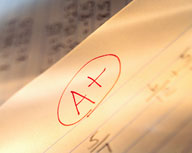

As a student you probably have a lot of experience with the concept of percent yield, although you most likely call them “grades.” Every time you take a quiz or test, you can yield a score of 100%. For most students, that doesn’t always happen. A score of 80% means that out of a “theoretical” 100 points, only 80 points were “actually” yielded. You could say that the student who made an 80 on a test had an 80% yield.
![]() What happens when the number of possible points is something other than 100? Let’s say the teacher has the following breakdown of points on an exam. Add the theoretical and actual points in the chart below.
What happens when the number of possible points is something other than 100? Let’s say the teacher has the following breakdown of points on an exam. Add the theoretical and actual points in the chart below.
How can you determine what grade the student got on the exam?
To get a percentage, you need to have a “part” and a “whole.” You also need to know that the ratio of the part to the whole is the same ratio as the percentage to 100. One way of showing this mathematically is as follows:

If you think about the terms “theoretical” and “actual,” you can easily replace the labels of “part” and “whole.”

“Theoretical” will always refer to the maximum amount. In this case, it is the maximum number of points that can be earned. “Actual” can be any amount less or equal to the “theoretical.” From the earlier example, a student cannot “actually” earn more points than the problems are “theoretically” worth.
If you rearrange your equation, which looks very similar to the math used for excess reactants, you get the following equation:

Here, the value of “x” is the “percent yield.” Try plugging in your numbers from the table using this equation.
![]() Graphically, the best option for representing parts of a whole is a circle graph. The entire area of the circle represents 100%. Look at the circle below, which has been subdivided into 10 pie pieces of equal area. Drag the pie pieces into the circle until the area in blue represents the percentage of points the student received.
Graphically, the best option for representing parts of a whole is a circle graph. The entire area of the circle represents 100%. Look at the circle below, which has been subdivided into 10 pie pieces of equal area. Drag the pie pieces into the circle until the area in blue represents the percentage of points the student received.